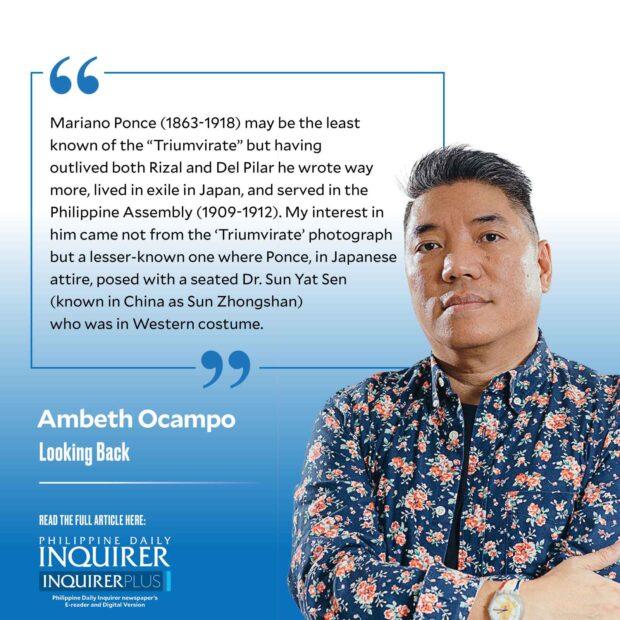
There is a famous photograph of the so-called “Triumvirate of the Reform Movement” taken in Madrid studio, in the 1890s, that depicts Jose Rizal and Marcelo H. del Pilar standing beside Mariano Ponce, seated, trying to look pensive.
All three were contributors to the reformist paper La Solidaridad and had interesting pseudonyms. Rizal used “Laong Laan” (ever prepared) and “Dimasalang” (untouchable). Among Del Pilar’s many pen names, the most famous is “Plaridel” a play on his surname, or his nickname “Selong.” He also used “Piping Dilat” (translated by Google as “dumbfounded”), Dolores Manapat, L.O. Crame, and D.A. Murgas. Ponce sometimes used his nickname “Naning,” other times “Kalipulako” (another name for Lapulapu) and “Tigbalang.”
Mariano Ponce (1863-1918) may be the least known of the “Triumvirate” but having outlived both Rizal and Del Pilar he wrote way more, lived in exile in Japan, and served in the Philippine Assembly (1909-1912). My interest in him came not from the “Triumvirate” photograph but a lesser-known one where Ponce, in Japanese attire, posed with a seated Dr. Sun Yat Sen (known in China as Sun Zhongshan) who was in Western costume. Ponce wrote and published one of the earliest biographies of the revolutionary who has gone down in history as the father of modern China. Both Ponce and Sun were plotting for the liberation of their homelands while in Yokohama, buying arms abroad and shipping them home. Ponce was unsuccessful, on the first try he was scammed by a certain “Nakamura,” on the second shipment the arms were lost in transit during a storm.
A selection of Ponce’s correspondence was published by the National Library in 1932 as “Cartas sobre la Revolucion” (Letters on the Revolution) that remains largely unread today, not only because physical copies of the book are scarce, but because many Filipinos remain cut off from their history because of language. It is hoped that the book can be translated from the original Spanish to English and Filipino someday to reach a wider audience.
Designated by the Aguinaldo administration as a diplomatic representative to Japan, Ponce entertained many Japanese journalists and sympathetic politicians both in his Yokohama home or restaurants in Tokyo using early public relations in the hopes of winning recognition for the Malolos Republic as a free and independent nation. From Ponce’s correspondence, we have an idea of his representation expenses in detailed accounting records for December 1898 to February 1899. Going over the list, it is not clear whether expenses were for personal or government accounts. Constant or regular expenses covered Ponce’s household that also doubled as his office: rent, servants, postage stamps, telegrams, trips, tips, and hospitality.
In December 1898 he spent: “[For] a trip to Kobe to receive Commission 119.97; Gifts for Christmas and New Year 37.10 (no names of recipients supplied); Pair of sillones (armchairs) 8.00; Wool camisetas (shirts) 4.50; Mesa escitorio (writing desk) 7; Desk clock 3.00; Photographs 5.60; Winter Coat 30.00; Two mattresses 8.00; Cloak, gloves, and Japanese overcoat for house 14.40; Wallet 4.30; Twelve photographs 4.00; Four trips to Tokyo to accompany Commission 18.78; Two dinners for Japanese friends 42.60.”
In January 1899, Ponce’s biggest expense was “109 for silk camisetas and socks for the President.” Did Aguinaldo order these or was this a late Christmas present bought cheaper on sale? Another entry was for “Trips to Tokyo 39.06.” More revealing were expenses for books that give us an idea of what Ponce read for work, interest, and pleasure. Titles are as follows: “International Law, Civil Code of Japan, Almanack de Gotha” (a reference book on European royalty, higher nobility, major diplomatic, military, and government corps. Also statistical data arranged by country.) “Le Japon Vrai” (The Real Japan), “Le Coree” (Korea), “History of Japan,” all for 18.10.
Part of the PR expenses of the Philippine representative in Japan went to: “Cigars and cigarettes 6.00; One dozen handkerchiefs and a travelling mirror 6.00; Visiting Cards (business cards or ‘meishi’ are a must then and now in Japan) 1.25; Decorations for sala 4.79; Trip to Kamakura with some friends 9.00; Doctor and medicines 17.00; A pair of shoes 4.75; Reproductions of photographs by [Juan] Luna 21.65; One ‘Smoking’ (an informal jacket worn in a smoking lounge) 33.00.”
In February 1899, he spent 5.00 on a pair of charol dress shoes (that he described in Spanish as “zapatos para pisto” or shoes to put on airs or as we would say today, “pang porma”). Other expenses were: Newspaper subscriptions, etc. 8.00; box and freight for Hong Kong 6.25; half a dozen cubiertos (silverware) 6.00; wine, biscuits, etc. 9.00; one book “Kojiki” (a book on Japanese myths and folklore) 4.00; and dentist 2.50. He gave a dinner for the newspaper Yorodzu Choho and another dinner for Sun Yat Sen. He bought “small gifts for people and journalists,” 38.00, and paid for a Japanese translator and interpreter, 30.00.
I have always been fascinated by historical lists and expenses because these are largely ignored as trivia, when in this case it can give you an idea not just of Ponce as a person, but what went into the foreign propaganda for the Malolos Republic.
—————–
Comments are welcome at aocampo@ateneo.edu